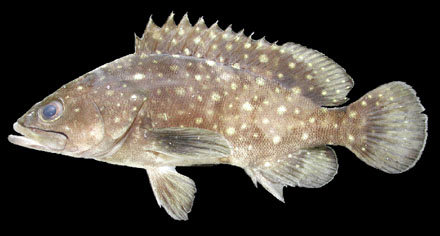
Epinephelus caeruleopunctatus, NSMT-P 65909, 9.7 cm SL
Epinephelus caeruleopunctatus (Bloch, 1790)
White-spotted grouper
|
|
D XI, 15 - 17; A III, 8; P1 17 - 19; LLp 51 - 61; GR 7 - 10 + 14 - 17. Body moderately elongate, the depth 3.0 - 3.4 in SL; head pointed, the dorsal profile nearly straight; preopercle rounded, finely serrate; opercular spines inconspicuous. Caudal fin rounded; pectoral fins large and fleshy, the fin length 1.5 - 2.1 in head. Scales on body of adults in a broad ctenoid zone along side of body, cycloid elsewhere; a patch of small scales on maxilla. Color: adults brownish gray, the body, posterior head, and dorsal fin with scattered large whitish spots and numerous pale spots; dorsal, caudal and pectoral fins with a very narrow white margin; a series of indistinct dark blotches at base of dorsal fin and one on caudal peduncle; prominent black streak on maxillary groove. Juveniles dark gray to black, covered with prominent pupil-size white spots and smaller white dots. Size: maximum length about 60 cm. Distribution: Indo-West Pacific: South Africa to Gilbert Islands and Fiji. It is not known from the Red Sea, but it does occur in the Persian Gulf. Remarks: closely related to, and often confused with, three other white-spotted species: E. ongus, E. summana, and E. corallicola. Occurs in rocky or coral-rich areas of deep lagoons, channels and outer reef slopes; usually in or near caves; depth range 2 - 65 m. Juveniles are found in tide pools.
|

 
|
|
